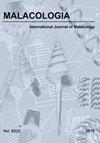Comparative Analyses of the Complete Mitochondrial Genomes of Three Lamprotula (Bivalvia: Unionidae) Species: Insight into the Shortcomings of Mitochondrial DNA for Recently Diverged Species Delimitation
IF 1
4区 生物学
Q4 ZOOLOGY
引用次数: 7
Abstract
ABSTRACT Freshwater mussels have suffered a severe decline during the last century. Accurate description and identification of species have been an arduous and important task for the conservation of this group. Recently, with the promotion of molecular technology, especially mtDNA, many morphological species have been merged. In the genus Lamprotula, L. caveata, L. cornuumlunae and L. leaii are recognized as valid species. The complete mitogenome of. L. cornuumlunae was firstly sequenced in this study. By comparing mitochondrial genomics and phylogenetic analysis, the results showed that mtDNA cannot distinguish between L. caveata and L. cornuumlunae. We hypothesized that the deficiencies of mtDNA in species delimitation was caused by very recent speciation. Time-calibrated multilocus divergence time estimation revealed that L. caveata and L. cornuumlunae recently diverged in the Neogene Pliocene. This study presents the potential problems of relying on mtDNA sequences for delimiting recently diverged species. We emphasis that mtDNA cannot be used solely or dominantly to understand biodiversity. Instead, it is indeed an effective tool, combined with more data, such as shell morphology, reproductive characters and biogeography, to integrate species concepts.三种Lamprotula(双壳目:单壳目)线粒体全基因组的比较分析——对线粒体DNA在近期物种划分中的缺陷的探讨
摘要淡水贻贝在上个世纪遭受了严重的衰退。准确描述和鉴定物种是保护该类群的一项艰巨而重要的任务。近年来,随着分子技术,特别是mtDNA的发展,许多形态物种被融合在一起。在Lamprotula属中,L.caveata、L.cornumlunae和L.leaii是公认的有效物种。的完整有丝分裂基因组。本研究首次对玉米乳杆菌进行了测序。通过线粒体基因组学和系统发育分析的比较,结果表明线粒体DNA不能区分洞穴乳杆菌和玉米乳杆菌。我们假设mtDNA在物种界定中的不足是由最近的物种形成引起的。时间校准的多焦点分歧时间估计表明,L.caveata和L.cornumlunae最近在上第三纪上新世分化。这项研究提出了依赖mtDNA序列来界定最近分化的物种的潜在问题。我们强调mtDNA不能单独或主要用于理解生物多样性。相反,它确实是一个有效的工具,结合了更多的数据,如外壳形态、繁殖特征和生物地理学,来整合物种概念。
本文章由计算机程序翻译,如有差异,请以英文原文为准。
求助全文
约1分钟内获得全文
求助全文
来源期刊

Malacologia
生物-动物学
CiteScore
2.00
自引率
0.00%
发文量
15
审稿时长
3 months
期刊介绍:
Malacologia publishes papers on all groups of the Mollusca. Malacologia specializes in publishing long papers and monographic treatments. Complete data are especially appreciated. Papers must be of interest to an international readership. Papers in systematics, ecology, population ecology, genetics, molecular genetics, evolution and phylogenetic treatments are especially welcomed. Also welcomed are letters to the editor involving papers published or issues of import to science of the day.
 求助内容:
求助内容: 应助结果提醒方式:
应助结果提醒方式:


